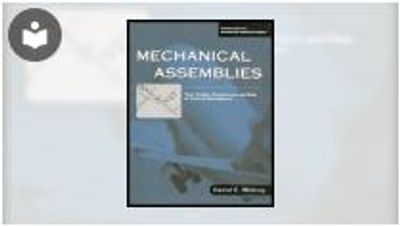Mechanical Assemblies: Their Design, Manufacture, and Role in Product Development
- 16h 33m
- Daniel E. Whitney
- Oxford University Press (US) Engineering
- 2004
Assembly is the process by which parts become products that do useful things. Yet the design of assemblies and the process of assembling them are not taught in universities. This book is the first to develop a systematic approach to modeling and design of assemblies. It addresses assembly on two levels. Assembly in the Small deals with the fundamental processes of assembling two parts using engineering fundamentals. Assembly in the Large develops a systematic theory for designing of assemblies as carriers of function, starting from methods for representing assemblies in a computer and including the basic properties of mechanical constraint. Important assembly analysis techniques such as predicting variation, Design for Assembly and generating assembly sequences are also covered.
In this Book
-
What is Assembly and Why is it Important?
-
Assembly requirements and key characteristics
-
Mathematical and Feature Models of Assemblies
-
Constraint in Assembly
-
Dimensioning and Tolerancing Parts and Assemblies
-
Modeling and Managing Variation Buildup in Assemblies
-
Assembly Sequence Analysis
-
The Datum Flow Chain
-
Assembly Gross and Fine Motions
-
Assembly of Compliantly Supported Rigid Parts
-
Assembly of Compliant Parts
-
Assembly in the Large: The Impact of Assembly on Product Development
-
How to Analyze Existing Products in Detail
-
Product Architecture
-
Design for Assembly and Other “Ilities”
-
Assembly System Design
-
Assembly Workstation Design Issues
-
Economic Analysis of Assembly Systems
YOU MIGHT ALSO LIKE



